
You can find snooker balls made from many different materials. These balls can be found in a range of colors and are smaller than other pool balls. These balls use lighter tips and smaller cues. Similar rules and table size allow you to use the same cue. Here are some things you should consider if you have a table for snooker.
Snooker pool balls in different colors
There are many differences in the colors of snooker pool balls. Some are neutral and work well with each other, while others are more striking. Blue and yellow pool ball colors complement one another, for instance. You can also get other pool balls to make your table unique. You can buy a set Ultraviolet or Granite balls to bring a little class to your table.
Most pool balls are solid red, but snooker uses a variety of colored balls. These can range from blue, yellow, green, and brown. The cueball is white. There are also stripes balls.
Materials used in the manufacture of snooker pool ball balls
There are many materials that can be used to make snooker pool balls. They were initially made of wood because it was cheap and easily accessible everywhere. However, the material was not long-lasting and easily changed shape. There were other materials available that could replace wood. In the nineteenth century, ivory was used to create the ball. The ivory balls could only be used four times per elephant because they were so expensive.

Over the centuries, the materials used in making snooker pools balls have evolved. Wood was a cheap material to work with, which is why it was the first material used. However, as time went by, Europeans started to develop a taste for other materials and began experimenting with these. In the seventeenth century, elephant tusks were used to create pool balls.
Size of a snooker pool table
Snooker tables can be larger than pool tables, and come with more accessories and features. Players must be able to control the ball and the playing surface must be smooth. The playing surface is made of a cloth, which can be made of either wool or nylon. These materials can be expensive but durable and last for many years. The size of your table is important, as well the materials used.
There are three main sizes for snooker tables. WPA table standard has wider pockets and angular ones. WEPF table table has smaller pockets. WPA tables have pockets two to three times larger than standard snooker balls. The WEPF table uses balls measuring two to two+1/4 inches (51 to 54 mm), while the WPA table uses smaller balls.
Rules for snooker pool games
There are many snooker pool rules. Your main goal is to score more points that your opponent. You can accomplish this by fouling or potting a ball. The game starts with a flip of a coin to decide who will be first. Each player places their cue ball in the D-shape. The goal of the game is for the red ball to be placed in the pocket.
Foul play occurs when the cueball comes in contact with a ball which cannot be put on. The player must remove the cue ball from another ball if it hits one. This also applies if another player nominates the ball.

There are snooker pool ball options
Snooker, a game that uses snooker pool tables, is an example of a sport. Each snooker table set includes twenty-two snooker balls. This includes a rack of fifteen red and six white balls. Many balls have a number to indicate their point values. There are two types of snooker balls available: the Aramith and English styles.
There are many options for snooker pool balls. Because wood was relatively cheap to produce, the earliest ball designs were made from it. As Europeans began to appreciate exotic materials, ivory was introduced. By the 17th century, ivory became the preferred material for pool balls. However, eventually, the elephant's tusks were endangered and manufacturers began to look for alternatives.